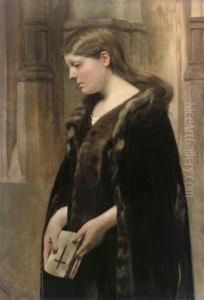F. Van De Vyver Paintings
Firmin Van De Vyver was a Belgian artist born in 1852, in Ghent, Belgium. His full name was Firmin Joseph Van De Vyver. Though not as widely known as some of his contemporaries, Van De Vyver was a skilled painter who contributed to the art world primarily through his work in genre painting, a style that depicts scenes from ordinary life.
Van De Vyver's artistic education took place at the Royal Academy of Fine Arts in Ghent, where many Belgian artists of the era received their formal training. His instructors were likely to have included some of the prominent Belgian painters of the time, who would have provided him with a strong foundation in the academic painting traditions prevalent in the 19th century.
During his career, Van De Vyver focused on creating works that captured the essence of daily life, often imbuing his subjects with a sense of dignity and grace. He was particularly adept at using light and shadow to bring out the textures and details in his paintings, which often featured interior scenes, religious themes, and portraits. His works were characterized by a meticulous attention to detail and a rich, yet subdued, color palette.
Van De Vyver exhibited his works in various salons and exhibitions, gaining recognition for his artistic talents. Despite this, he did not achieve the same level of fame as some of his peers. Nevertheless, his paintings do appear in art auctions and collections, appreciated by those who have a keen interest in genre painting and 19th-century Belgian art.
Firmin Van De Vyver passed away in 1933, leaving behind a modest but meaningful body of work that continues to be studied and admired by art historians and collectors. While his name may not be immediately recognizable in the broad narrative of art history, his contributions to the Belgian art scene of his time remain an integral part of the country's rich cultural heritage.
